Caldwell, ID. Over a decade and a half ago, I studied epistemology with Esther Lightcap Meek in Old Main, a beautiful 1881 building on the campus of Geneva College in Western Pennsylvania. Our basement classroom had character. The radiator pipes would clank and hum in the middle of discussions, as if we were being joined by the ghosts of those poor students who had failed philosophy and were forever doomed to haunt the halls of Old Main.
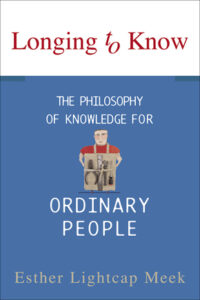 The topics we explored in class threw me into something of an existential crisis, and Professor Meek was kind enough to help me work my way back out of it. At the time, she had recently published Longing to Know: The Philosophy of Knowledge for Ordinary People. Since then, she has followed that book with Loving to Know: Covenant Epistemology, A Little Manual for Knowing, and Contact With Reality: Michael Polanyi’s Realism and Why It Matters. Among other themes explored below, each of the books is marked by a deep engagement with the thought of scientist and philosopher Michael Polanyi (for more on Polanyi, see Front Porch President Mark Mitchell’s fine biography), as well as vivid examples—some playful, others painful, all thoughtful—of how his insights have helped Meek make sense of and transcend her own and others’ epistemological dead ends.
The topics we explored in class threw me into something of an existential crisis, and Professor Meek was kind enough to help me work my way back out of it. At the time, she had recently published Longing to Know: The Philosophy of Knowledge for Ordinary People. Since then, she has followed that book with Loving to Know: Covenant Epistemology, A Little Manual for Knowing, and Contact With Reality: Michael Polanyi’s Realism and Why It Matters. Among other themes explored below, each of the books is marked by a deep engagement with the thought of scientist and philosopher Michael Polanyi (for more on Polanyi, see Front Porch President Mark Mitchell’s fine biography), as well as vivid examples—some playful, others painful, all thoughtful—of how his insights have helped Meek make sense of and transcend her own and others’ epistemological dead ends.
Meek is Emeritus Professor of Philosophy at Geneva College. She is also a Fellow/Scholar with the Fujimura Institute, and Board Member for the Michael Polanyi Society. She is currently at work on Doorway to Artistry, the first volume in Doorways, a series relating her philosophy to different areas of life, and she now resides in Steubenville, Ohio.
MS: How has Wendell Berry helped you ask deeper epistemological questions and come to better answers to those questions? In Loving to Know, you mention Remembering several times, as well as Jayber Crow. For those readers who are familiar with Berry but unacquainted with your work: how does Berry help illuminate ideas you’ve been pondering? What does the center of a Meek/Berry Venn Diagram look like?
ELM: Given the way my personal philosophical quest has unfolded, I developed my covenant epistemology prior to reading Remembering. But I have reread and taught that pearl of a book every semester in a core humanities curriculum for fifteen years. Yes, it displays so well multiple dimensions of my thought—there’s lots in the center of that Meek/Berry Venn Diagram! I feel that Berry’s wisdom validates my philosophical proposals. And he shows how covenant epistemology lives out. I love the book!
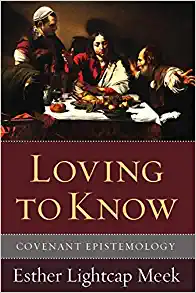 Covenant epistemology (CE) is my proposal that the paradigm of knowing is the interpersonal, covenantally constituted, transformative, encounter and unfolding relationship. In Loving to Know: Introducing Covenant Epistemology (L2K), I pose covenant epistemology in healing challenge to our persisting modernist epistemology. We need epistemological therapy. The argument culminates with an epistemological etiquette, best epistemic practices which invite the real. All of these emphases are evident in Remembering.
Covenant epistemology (CE) is my proposal that the paradigm of knowing is the interpersonal, covenantally constituted, transformative, encounter and unfolding relationship. In Loving to Know: Introducing Covenant Epistemology (L2K), I pose covenant epistemology in healing challenge to our persisting modernist epistemology. We need epistemological therapy. The argument culminates with an epistemological etiquette, best epistemic practices which invite the real. All of these emphases are evident in Remembering.
Remembering shares with CE the mission to challenge and dispel things modernist. In L2K I speak of the defective epistemic default (DED—dead!). Elsewhere I call this the knowledge as information mindset. I identify what I playfully term its daisy of dichotomies—that is, all the binaries engrained in it: knowledge vs. belief, fact vs. value, reason vs. faith, objective vs. subjective, public vs. private, and so on. The first member of each ordered pair is privileged (in the center of the daisy), and the second delegitimated (on a petal). The modernist milieu deems the first, knowledge, as over against the second. Persons and responsibility do not appear anywhere on the daisy, except possibly as relegated to a petal.
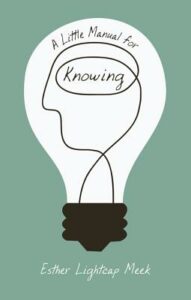 Since modernity has delegitimated philosophy too, having exalted the pragmatic, most people aren’t even aware of all the skewed philosophical presumptions we all have inherited about knowing. Yet they play out in all that we think and do. We wrestle with them, trying to keep the binaries in tense balance. But they are depersonalizing and suffocating us. Modernism tempts us, as Berry understands, with limitless mastery and no responsibility. But it foments—and here I name just the things Berry identifies in Remembering–absence, anonymity, voyeurism, disregard for the other (nature and people—the real) and consequent wreckage, fragmentation, solitariness, abuse of power.
Since modernity has delegitimated philosophy too, having exalted the pragmatic, most people aren’t even aware of all the skewed philosophical presumptions we all have inherited about knowing. Yet they play out in all that we think and do. We wrestle with them, trying to keep the binaries in tense balance. But they are depersonalizing and suffocating us. Modernism tempts us, as Berry understands, with limitless mastery and no responsibility. But it foments—and here I name just the things Berry identifies in Remembering–absence, anonymity, voyeurism, disregard for the other (nature and people—the real) and consequent wreckage, fragmentation, solitariness, abuse of power.
Berry grasps that modernism must be, and can only be, dispelled with something of an entirely different order. In Remembering it’s really hard to miss his proposed responses to dispel modernism. Over the years of teaching the book, I have made flashcards of word pairs and had students write the one item in the modernist column and the other in the response column. Absence; presence. Control; covenant. Isolation; membership. Blindness; seeing. Abstract; concrete. Irresponsibility; choice and consent. Thinking; bodily feeling. Universal; partial. Information; understanding. Leaving; returning. Disembodiment; embodiment. Anonymity; being known. Mastery; redemption. Dismembering; re-membering. These are not daisy binaries; these are modernity-dispelling responses.
I pose that we need to undergo what I call epistemological therapy, not to balance the daisy binaries, but to dispel the entire daisy. I believe that a positive alternative epistemology is essential to this. I found this alternative in the innovative proposal of premier scientist-turned-philosopher, Michael Polanyi. It’s called subsidiary focal integration (SFI). Of course, Berry doesn’t use such jargon, but you can still identify it in Remembering.
All knowing is subsidiary focal integration, Polanyi says. You are already quite good at it, for this is how knowing actually, naturally, works. All knowing has a from-to structure: you rely on (entrust yourself to) unspecifiable clues or subsidiaries to creatively shape and submit to an integrative and irreducible pattern. You attend from subsidiaries which you give yourself to to indwell, which you creatively meld within the pattern. The subsidiaries now are fraught with meaning as you attend to a focal pattern. Subsidiaries include your felt body sense, the clues of your place of puzzlement, and the maximic words of authoritative guides. You see the SFI structure in the aha! moment of insight, but you continue that from-to stance in all the knowing you carry out. It is a profess-sion, a posture of responsible orientation to the real. The irreducible, transformative, integrative pattern lays hold of an aspect of an inexhaustively rich and surprising real.
Sound complex? Just try relating it to your experience reading a text (as you are right now) or riding a bike. SFI is how we actually know in everything we do—even in the proper, rejuvenating, implementation of information. Keeping your balance is a prime example of subsidiary awareness. It is both inarticulable and palpable, dynamic, even trainable. So is the meaningful grasp of words we read. It’s our wholesale subsidiary indwelling of our bodies which make them feel to be our own, says Polanyi. The same for any other tools we indwell, including theoretical frameworks.
If you revert to focus on, scrutinize, what is meant to be subsidiary, the integrative pattern disappears. This includes a kind of stepping back out of your body. Polanyi called this “destructive analysis.” There are times throughout the process of coming to know that destructive analysis is necessary and helpful, but it is risky in that it can permanently undo the pattern. The point is that it is meant to be temporary. Focal knowledge of explicitly articulated information, the modernist ideal, is actually destructive analysis, focusing on what is meant to be subsidiary. It should not be the paradigm of knowledge. It actually blinds us to knowledge. Instead, knowledge requires—and accredits—unspecifiable from-understanding. For understanding—and for reconnecting with the real, you have to climb back into the clues, returning to entrust yourself to them, indwell them as they are restored to open the world to you.
SFI plays out in Remembering with respect to Andy’s amputated right hand and his prosthesis. And of course this images Andy’s whole soul’s disorientation. He is fixated on his awkward, failing body, disembodied in the process. He’s rejecting his body. When finally he “returns to himself,” he picks up the hated prosthesis out of the trashcan where he has pitched it: it is just a tool. I also love that Andy’s return to proper orientation to the world in knowing begins with simply allowing himself to return to feel and smell and hear again, to trust the real, beginning with his bodily feeling the memory of Nathan Coulter’s grasp of his arm stump.
Knowing a la subsidiary focal integration opens the world, connects you to and within the world: all knowing is from-to, through and beyond. Polanyi, as a premier scientific discoverer at the beginning of the twentieth century, himself challenged modernist epistemology as simply not what scientists do: if they did, no scientific discovery would ever occur. But it does. You have to countenance an epistemology which makes sense of not yet knowing, of clues, in submissive pursuit of a half-hidden objective real which exercises primacy.
I got my start in life and philosophy, it appears, by being a child skeptic: I felt I had no proof of the real beyond my disembodied mind! As it turns out, my very question had been spawned within the antirealist modernist milieu, proof positive of its fundamental distortion. Rejection and distrust of the real is paramount, along with our attempt to bend it to our mastery. (Dehumanize first, then abuse.) But in my own quest for the real, Polanyi the discoverer’s frequent promise was water on my parched soul: you know you have made contact with reality when you have an unspecifiable sense of an inexhaustive range of future manifestations. A sense of future prospects which you cannot yet name. Reality does not so much answer your questions as explode them. You must come to live life on the terms of the real.
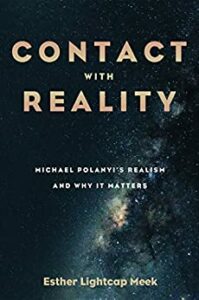 Over the years I myself have healed philosophically, something I chronicle in my 2017 Contact With Reality. My own question has been exploded. I now consider myself an exuberant realist. I affirm with delight the primacy of the real. In my L2K I get at this by arguing that reality is personlike in its inexhaustive depths and possibilities. So knowing should be seen more like a covenant of marriage: we promise to love, honor and obey, and only then, in grace, may the real reveal itself.
Over the years I myself have healed philosophically, something I chronicle in my 2017 Contact With Reality. My own question has been exploded. I now consider myself an exuberant realist. I affirm with delight the primacy of the real. In my L2K I get at this by arguing that reality is personlike in its inexhaustive depths and possibilities. So knowing should be seen more like a covenant of marriage: we promise to love, honor and obey, and only then, in grace, may the real reveal itself.
Subsidiary focal integration absolutely requires letting go of one thing, in hope, to grasp another! This is a kind of forgiveness. It also is essentially a consent, a choice, a trust, a covenant. It essentially involves risky responsibility. It involves a humble return and regard for particularity, including one’s own body, place, and time. It also involves submission to the other, the personlike real. Knowing involves a being known, in mutuality, transformatively. In my work I augment SFI along these interpersonlike lines. And if reality is personlike, then best epistemic practice involves inviting the real—not controlling, demanding, or raping it. The goal of knowing, I argue, is not comprehensive information to the end of mastery, but rather convivial communion with the real. I call this the loving-to-know mindset. We do not know in order to love; we love in order to know.
Anyone intimate with Berry can see that all these ideas are evident in his work. You can see that Andy’s getting over himself involves a letting go, a self-forgiveness. It is essentially consent, choice, covenant, trust, humility, return, regard, being known—all stridently disavowed by modernity, yet the very key to knowing and communion with the real. All this is patent in the Port William membership. I love how Berry says in the Moyers interview that the farmer does not tell the land what to grow, but rather listens, and asks: what do you need?
Berry conveys the grim challenge of dispelling modernity. At the same time, he shows how simple it is to dispel it concretely, bringing small but real and vibrant light and healing that stands out easily in the darkness. Membership. Re-membering. Front Porch Republic. Loving to know.
MS: How do you respond to those who read your description of covenant epistemology and worry that your emphasis on the personal dimension of knowledge will eventually devolve into mere relativism? How does your epistemological humility relate to your confidence in what is ontologically real?
ELM: Actually, I believe that it is those who do not read covenant epistemology who fear that it devolves into mere relativism! Longing to Know is a good place to start, since it is brimming with illustrations from everyday life. Within the brief sketch I have offered here, let me just point back to the examples of reading, and of bike riding: keeping your balance is essentially inarticulable. But it is palpable, trainable, a risky commitment to a crazy contraption. It is definitely not relativism! Bike riding also easily displays the humble confidence (and joy!) which lies at the heart of unfolding communion with a lively, inexhaustively rich, real.
Modernist epistemology exalts a false ideal of exhaustively explicit and focal, comprehensive information, to the end of certainty. If certainty is your ideal, then of course the only alternative is relativism. This approach is inherently self-protective, absolving oneself of the risky responsibility and humble consent to the real. It’s also crippling. It’s just not what we do when we know well. It’s not what we do when we are on the path of a discovery—as Polanyi said. In covenant epistemology we are in no way settling for something less; we are holding out for something superior: virtuosity in communion with the real.
I tell my students, this is what certainty looks like: Certainty is Ben Roethlisberger (quarterback for the Pittsburgh Steelers) standing on the 50-yard line, reading out the information in the playbook. This is definitely not what he is paid to do. He’s paid for his artistry in making plays unbelievably well—making contact with reality. Subsidiary focal integration is patently visible every game. Certainty would be a straitjacket to a ballplayer. What you want is confidence. And don’t tell me that athletics isn’t knowing!
MS: How might a wider embrace of covenant epistemology have helped us work through the various political and cultural conflicts of the last few years, and especially since the COVID-19 epidemic? There seems to be a deep undercurrent of epistemological failure running through quite a few phenomena. I think it is safe to say that we are truly bipartisan in these epistemological failures as well. I think of the rise of “fake news” and “alternative facts,” cancel culture, Trump and Trump Derangement Syndrome, the silo effect of social media, the “woke” and “red pill” ways of framing events, the intense debates over the relationship between scientific research, public health, and political authority, etc.
ELM: I would say that in all this we see the DED, modernist epistemology, playing out destructively. Of course there is much more to it, but this at least is a component. If knowledge is information to the end of comprehensive control, utility with necessary disregard for the other, certain fundamental things are marginalized: the personal other (and thus ourselves, our place and community), (which is also) the real, and the true. If we begin with Bacon’s era-defining, “knowledge is power,” of course we end up with “. . . power.”
Here are a couple other components of covenant epistemology which address our cultural strife healingly. The first has to do with the essential role of authority, a normative component, in all knowing. I already mentioned the component role of authoritative guides, as one sector of subsidiaries, in knowing. Modernist epistemology entirely disavowed the role of authority in knowing; now it has actually fallen prey to the very thing it rejected. We seem to be at the mercy of the question, “Who says?”
But authoritative guides teach us to see what is there. Wheeler Catlett tries to get his son Andy to see the cows drinking at the spring. Matt Feltner learns from Uncle Jack Beechum to see what was there all the time: Redemption—a little flowing stream. But both simultaneously make the point that it is up to us to consent to see it. Authoritative guides aren’t meant to replace our own responsibility in submission to the real.
Better to reinstate an epistemology which acknowledges the responsibly prudent assessment of maxims which we must indwell. This requires an epistemology which accredits unspecifiable know-how. Intrinsically related here is the essential component of something like obedience: you have to enact the maxims before you can expect to understand. Does this sound scary? It is common fare for piano lessons and figure skating. And farming. We all continually navigate and must assess the matrix of authoritative guides.
Another component of CE helpful for our cultural and political conflict is perichoresis. The act of coming to know, of responsible communion with the real, must be dancelike—overture and response. Following the thesis of Colin Gunton’s The One, The Three, and the Many, I pose that the “motion” of modernity is an endlessly tense opposition, a fight between the One and the Many, that is, a totalizing universality or a fragmented particularity. One triumphs only with the weakening of the other. This dynamic seems prominent in our world. It is never stable, and homogeneity wins: in ultimate particularity, everyone is unique, just like everyone else. There is no regard for the other.
But there is a healing dynamic of the real: perichoresis. Gunton says that we must balance, not one and many, but relationality and particularity. These do not oppose each other; rather, they feed and grow each other. The relationality of partners in a dance enhances the individual dancers; the particularity of each enhances the dance. This is the healing motion we should aspire to. Where it pertains, whether in a football team or a jazz ensemble, a neighborhood or Congress, there is relational health and wholeness. Again, the Port William membership. Andy is perichoretically rewoven back into its fabric, as were others before him. Perichoresis is dynamic involvement and consent that embodies regard for the other—the other who is the same as me but different from me. This is the dynamic of friendship (as opposed to abusive absorption). It is the heart dynamic of subsidiary focal integration, of communion with the real. Would it not also make irenic sense to pursue it in bipartisan politics and the common good?
Two final, unargued, comments about our era of political and cultural conflict. First. Where falsehood is foundational—conspiracy—rather than the real and the true, this dismantles knowing, and it dismantles a society. Of the pair, false and true, the false can only make sense in light of the more fundamental true, not vice versa.
Second. My Granny Harvey emphasized this maxim: Only say what is true, kind, and necessary. Good manners grow out of regard for the real other. They are good policy, enabling perichoretic conversation and deliberation.
MS: Michael Polanyi has been your intellectual companion for many years now. You’ve offered his realism as a challenge to both stale, impersonal objectivity and a solipsistic subjectivity that is little more than nihilism (note to readers: this is my short summary; Loving to Know is much more nuanced). Based on shifting philosophical, political, and cultural trends, has your assessment of which of these epistemological dead ends is more in need of active challenge changed? Or is it always a two-front war?
ELM: What I have said already applies here. We need to dispel the daisy of the defective epistemic default of modernist epistemology, not inadvertently leave it ensconced in a combative, oppositional compromising. We need to redraw the playing field epistemologically. The question is, what does this look like? How do we live it out? I believe that the Front Porch venture endeavors to do this: to reinstate and accredit a palpably healing, unavoidably interpersonal, covenantal and perichoretic, situation of lively community in the venture to regard, understand, and address life in the streets.
MS: Your approach to philosophy is remarkably irenic, and intentionally so. While it is refreshing to read scholars who are not always on the warpath, there is still the lingering question: how do you deal with the active destroyers out to simply cause chaos?
ELM: This is such a great question! First, thank you for perceiving this about my work; it means a lot. As a person, I want my approach to dispute to be “disarming”—with its double meaning! Rather than confront, I like to redraw the dynamic in a way that begins hospitably. Second, you are right: the irenic in this epistemology is structural and fundamental. SFI involves harmonizing components which, when viewed focally, were contradictory. CE involves loving in order to know. It has a natural, healing, effect. People may have little training in philosophy, but we all feel this in our bodies. Philosophy is not abstract; it is actually quite concrete.
Over the years teaching college students—teaching an array of opposing philosophical ideas to college students!—I’ve come to say this: it is a mistake to think that you have only two options, agree or disagree. If you think this, whichever option you choose, you get absorbed by the thing you oppose. There are at least three options: agree, disagree, and listen. In listening, you can become, as Blythe Clinchy writes, “mentally pregnant with the other.” Listening intrinsically confers dignity on the other, and it actively transforms the real. The real wants to be heard and seen and known, so that it may become itself more fully. This is irenic.
MS: You have taught in a variety of classrooms over the years. What might teachers learn from your work?
ELM: Obviously one’s approach to education fundamentally involves an anthropology and an epistemology. In a milieu of strident modernism, teachers and institutions are deeply marked. And since modernism is anti-philosophical, most aren’t even aware of this grievous state—even if they have a PhD—a Doctorate of Philosophy. Much, much epistemological therapy must be carried out continually. At the same time, against this grim modernist backdrop, instances of subversively therapeutic healing stand out as candles merrily thrusting back the darkness. And where there are great teachers, this happens regularly. I tell my students that you want to study with a prof who has a twinkle in their eyes—both for the topic, and for you. We love in order to know.
I argue that the goal of teaching is to produce lovers—lovers of the real. Covenant epistemology’s etiquette of best epistemic practices doubles easily both as pedogogical practice and as maximic guidance for students in whatever the area of expertise which concerns you. SFI also shows the way to growing a perichoretically healthy and healing learning community—a true collegium. There is much more to say here, but perhaps it can wait for the book.
MS: What is ahead for you as a philosopher?
ELM: As you may imagine, now that I’m an exuberant realist, ahead lies a world of possibilities! Just now having become Emeritus as Professor of Philosophy at Geneva College (where you were my student, Matt!), I am continuing to work freelance as a creative philosopher, thinking, writing, teaching, and speaking.
I’m writing the first in a projected book series, in which each book develops my philosophical proposals within a different arena of life. The series, with Cascade Books, is called, Doorways. This first book is Doorway to Artistry. I anticipate further volumes addressing business, therapy, and education.
Additionally, I’m very glad for opportunities such as this one with FPR. My vision is to steward these philosophical proposals and therapy, to the healing of others and our world. I want to make the most of connections with other people and discussions to get the word out.
Finally, just this past year I moved from my porchless home of seventeen years in an isolated, suburban, cul-de-sac, to the neighborhood of my daughter and family, where real perichoretic community is occurring, in a post-industrial town where thoughtful revitalization is underway. My quirky old craftsman house has the best front porch ever! High above this Ohio River bluff, swallows merrily twitter and interweave, especially in the evening light. Following their example, I’m feeling my way to joining in the dance.
MS: Thank you kindly for this interview and for your books. It was a delight to revisit these ideas!
Image credit: Esther Lightcap Meek, from her front porch in Steubenville.




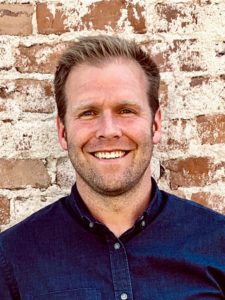
1 comment
Rob G
Currently reading After Humanity, Michael Ward’s excellent new book on Lewis’s The Abolition of Man. Lots of resonances here.
Comments are closed.